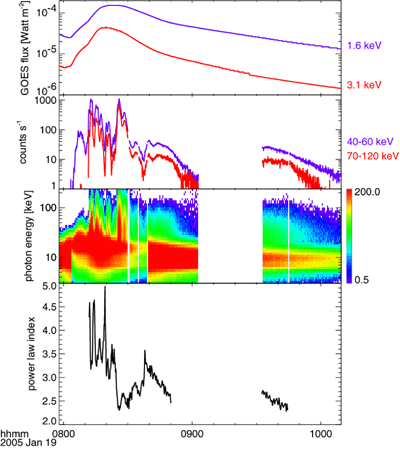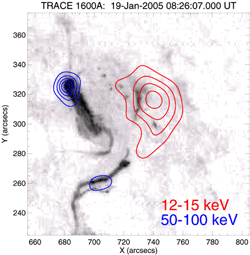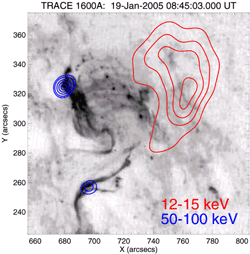Introduction
Solar flares emit hard X-rays that indicate, via
bremsstrahlung, the presence of high-energy electrons.
We know (and the RHESSI data
copiously confirm) that the acceleration of these electrons
somehow absorbs a large fraction of the total flare energy.
This energy appears during the
impulsive phase
of the flare. At the same time that the spectacular flare loops form in
the corona, an even more spectacular
coronal mass ejection may appear.
The impulsive-phase particle acceleration follows a specific and
well-defined pattern of spectral evolution (see a past by Paolo Grigis).
We call this the "soft-hard-soft" morphology, because during each peak
of emission the hard X-ray spectrum, and hence the parent spectrum of
the high-energy electrons, shows a local maximum of "hardness" - i.e., the
spectrum is flattest at times of peak flux.
The theoretical implications of this morphology may or may not be profound,
but they obviously reflect features of the largely unknown particle
acceleration and transport mechanisms in the solar coronal magnetic fields.
In this nugget we discuss one of the new morphologies that RHESSI is now
exploring.
An alternative "soft-hard-harder" spectral evolution was noted in exceptional
cases from the earliest hard X-ray observations, and Alan Kiplinger showed
in 1995 that this hard X-ray signature anticipated the occurrence of a CME
and high energy proton events, a most important element of
space weather which affects our environment on or near Earth.
Late-phase hard X-ray spectra
Often enough the impulsive-phase morphology is all that you see in a solar
flare, and indeed the RHESSI (and earlier) data show that this property
characterizes the weakest observable microflares as well as major events.
In the soft-hard-harder morphology one sees a steady spectral hardening
superposed on this pattern, as shown in the figure below.
Usually it has a smooth time variation, but it may also show a bursty
character.
In rare extreme cases one may only see only the soft-hard-harder pattern.

Figure 1.
An illustration of two spectral morphologies seen in the RHESSI observations
of a flare hard X-ray burst on January 19, 2005.
The initial spikes follow the soft-hard-soft pattern, while the later phase
shows a soft-hard-harder pattern.
The bottom panel shows the spectral index (small is hard) and the
next-to-bottom panel shows the RHESSI spectrogram (see a
previous nugget for a
description of the RHESSI spectrogram)
The active region producing this flare had several other major events (seven
X-class flares during its disk passage) that we hope to describe further in
future nuggets.
They showed various degrees of the "pure" soft-hard-soft pattern and
the "late phase" soft-hard-harder one.
Where are the sources?
Of course with RHESSI we can image the sources, and it's immediately
interesting to ask whether or not the late-phase image morphology
differs from the impulsive phase.
We were surprised (though Qiu
et al. 2004 had already pointed this out for an
event observed by
Yohkoh) to find that the images during the two different phases look
quite similar, as shown below:
Figure 2. Images of the same flare taken in the impulsive phase
(left) and
gradual
phase (right).
Both show clear loop-top soft X-rays (12-15 keV) and footpoint hard
X-rays (50-100 keV).
Conclusion
The late phases of solar flares sometimes show a quite different spectral
morphology; this is associated with radio type IV bursts and with CMEs and
reflects the acceleration and trapping of high-energy electrons in solar
loops.
The image morphology is not all that different from that of the impulsive
phase, but clearly we are seeing different patterns of particle acceleration
and propagation (trapping) in these loops.
Note that the particle acceleration near the Sun has thus been
confirmed to continue long after the impulsive phase.
This is important because it cannot be readily explained by the
well-established concept of
shock acceleration of solar particles.
Biographical note: Säm Krucker and Hugh Hudson are RHESSI team
members at Berkeley.


